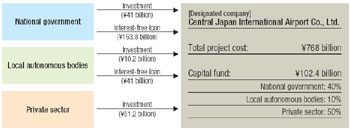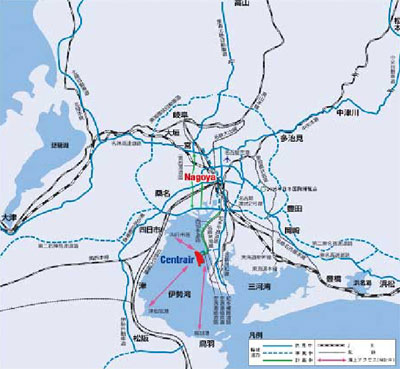Ocean Newsletter
No.78 November 5, 2003
-
The present status and the operating structure of Central Japan International Airport, "Centrair" - Centrair is the aerial gateway for the "2005 World Exposition, Aichi, Japan" -
Kunikatsu Yamashita Senior Executive Vice President, Central Japan International Airport Co., Ltd. / Selected Papers No.6(p.11)
The population and the shipment value of manufactured products in the Chubu Region (consisting of nine prefectures) account for approximately one sixth and one fourth of Japan's totals, respectively. Accordingly, it has the strongest potential after the Tokyo Region and the Osaka Region, and its economic scale exceeds that of Canada or Spain. The Central Japan International Airport (nickname: Centrair) has been constructed as a round-the-clock international airport in the Chubu Region off the coast of Tokoname City in Aichi Prefecture, aiming at the opening in February 2005. Preparation for the opening is being made for realizing the gateway which would connect the Chubu Region with the world, by utilizing an excellent traffic access, approximately 30 - 40 minutes from the heart of Nagoya City.
Selected Papers No.6(p.11) -
Recommendations of the "Investigation committee on countermeasures against abandoned ships by cooperation among three water areas" On the future direction for countermeasures against abandoned ships
Atsushi Sakai Special Assistant to the Director of the Division of Environment Planning Office, Ports and Harbors Bureau, Ministry of Land, Infrastructure and Transport
A fact-finding survey about pleasure boats in Japan was conducted in the fiscal year of 2002 by the Ports and Harbors Bureau and the River Bureau of the Ministry of Land, Infrastructure and Transport, as well as the Fisheries Agency. The survey result showed a decreased percentage of abandoned ships compared with the last survey result obtained in the fiscal year of 1996, however, it also turned out that there still exist a large number of abandoned ships in public water areas and those ships cause serious problems for appropriate management of public water areas as well as for maintaining the living environment of the surrounding areas. Receiving this survey result, the Ports and Harbors Bureau and the River Bureau of the Ministry of Land, Infrastructure and Transport, as well as the Fisheries Agency, jointly established the "Investigation committee on countermeasures against abandoned ships by cooperation among three water areas," and the committee has recently made recommendations on the future direction for countermeasures against abandoned ships.
-
Learning about tidelands during comprehensive learning period - "Let's play, study and report," we are an expedition team to the tidelands -
Tsuneo Imai Teacher, Kisarazu Municipal Kaneda Elementary School, currently working for Tenjinyama Elementary SchoolSachiko IsogaiTeacher, Kisarazu Municipal Kaneda Elementary School
Kaneda Elementary School of Kisarazu City has classes entitled "Obitsu River Estuary Tideland," in which pupils learn about a familiar environment as a domestic science subject or as comprehensive learning, in all the grades. Children repeatedly learn about tidelands in parallel with various experiences, and gain deeper understanding by changing their objects of interest as they grow. Through this learning about tidelands, children who can gain thoughtful views and visions about the environment are being educated.
The present status and the operating structure of Central Japan International Airport, "Centrair" - Centrair is the aerial gateway for the "2005 World Exposition, Aichi, Japan" -
The population and the shipment value of products manufactured in the Chubu area (consisting of nine prefectures) accounts for approximately one sixth of the population of Japan and one quarter of the shipment value of products manufactured in the country, respectively. The Chubu area has the strongest potential after the Tokyo and Osaka areas and its economic scale surpasses that of either Canada or Spain. The Central Japan International Airport (also known as Centrair) is now under construction as a 24-hour a day international airport in the Chubu area off the coast of Tokoname City, Aichi Prefecture, with an anticipated opening date of February 2005. The airport is conveniently located approximately 30 to 40 minutes from the heart of Nagoya City and preparations for its opening as a gateway connecting the Chubu area with the rest of the world are presently being made.
1. Mechanism of the Central Japan International
Airport Project Central Japan International Airport Co., Ltd. was designated as the entity to establish and manage the Chubu International Airport in July 1998, based on Article 4 of the Law Concerning the Provision and Management of the Chubu International Airport. Central Japan International Airport Co., Ltd. is a business corporation under the commercial law and it aims at (1) the establishment and management of the Central Japan International Airport, aeronautical navigation aids and functional facilities handling passengers and cargo, (2) the construction and management of stores and other facilities for the convenience of patrons, and (3) the carrying out of incidental projects. The total cost of the project is ?768 billion and an investment and interest-free loan was provided by the national government, local autonomous bodies and the private sector for 40% of the total cost, while an interest-bearing loan accounts for the remaining 60%. The capital fund is ?102.4 billion and the contribution rates of the national government, local autonomous bodies and the private sector are 40%, 10% and 50%, respectively. Private sector funds and management expertise are being actively utilized (Figure 1).
2. Progress of construction work
 Figure 1: Project scheme of Central Japan International Airport Co., Ltd.
Figure 1: Project scheme of Central Japan International Airport Co., Ltd.
| Destination | Departure airports | ||
|---|---|---|---|
| Narita | Kansai | Nagoya | |
| U.S. | 59% | 8% | 33% |
| Europe | 59% | 8% | 33% |
| Asia | 15% | 7% | 78% |
| China | 13% | 13% | 74% |
| Oceania | 27% | 8% | 65% |
| Total | 34% | 8% | 57% |
Shore protection work was delayed for about six months from the original schedule and commenced in August 2000, due to a delay in compensation for fisheries around the construction site. However, efforts are being made to shorten the period of construction work by dividing the construction site into several sections for land reclamation work, and starting reclamation work first for the passenger terminal area - which requires more time for construction work - instead of starting on the construction of the passenger terminal building and others after land reclamation has been completed for the entire airport island. As a result, construction work for the passenger terminal building started in January 2002 and is scheduled to be completed in September 2004. The entire 470-hectare land reclamation for the airport was completed in February 2003, so construction work on the runway and taxiways commenced in the same month and is scheduled to be completed in the spring of 2004.
3. Consideration of the environment
Among airport providers in Japan, Central Japan International Airport Co., Ltd. was the first to obtain ISO 14001 certification, the international standard for environmental management systems, in December 2000. In order to reduce environmental loads, the company is also working on the following:
Consideration of the sea environment: Taking the sea environment into account, curved lines were introduced into the configuration of the airport island, the width of the sea area between the airport island and the opposite bank was widened and round corners were introduced so that they would not impede currents.
Consideration of ecosystems: In striving for harmony with nature, sloped banks were employed as a base with the use of natural stones on the airport island. In addition, a rocky underwater forest of a 10-meter width was created for the west and south sides of the banks (approximately 6.5 kilometers) in consideration of marine life habitats. Furthermore, in order to take all possible measures to ensure environmental conservation, environmental monitoring is being conducted and the results publicized.
Consideration of aircraft noise: To reduce aircraft noise over land, the runway and flight paths were carefully laid out. It is estimated that any aircraft noise exceeding environmental standards will not reach beyond the sea area.
4. Introduction of universal design
We are aiming for a passenger terminal building based not only on barrier-free design, but also on the concept of universal design so that the facilities will be convenient for all users, regardless of age or disability. Toward this end, we organized a workshop on universal design and received various proposals from scholars and movement-limited groups in the community with which consulting contracts were concluded. In practical terms, routes for departing and arriving passengers will be provided on the one floor so the trouble of moving to other floors will be eliminated. Elevators will also be easily accessible to disabled persons and moving walkways will be provided.
5. Cost reduction efforts
Various efforts are also being made to reduce the cost of providing various facilities at the airport based on a policy of open and fair competition. Namely, consulting is to be provided by businesses that are familiar with building construction, the introduction of market prices is being promoted and construction methods that reduce construction costs without sacrificing reliability and the quality of construction work are being proposed and implemented by businesses. For the total cost of the project, we now expect that a total of approximately ?100 billion will be saved - ?60 billion for land formation, ?34 billion for lowered interest rates and ?6 billion for the postponed provision of facilities. As for future construction work, we will make every possible effort to continuously reduce costs.
6. Future issues
We have much to do after the opening of Centrair in order to improve air routes and increase demand for air travel. Table 1 indicates the results of a questionnaire that was conducted in the summer of 2002 by the "Council on the Promotion of the Use of the Central Japan International Airport," which consists of members from local autonomous bodies and economic circles, regarding "Airports used for overseas business trips in the Chubu area." The questionnaire was sent to about 60,000 business travelers from 300 companies in Aichi, Gifu, Mie, Shizuoka and Nagano in order to survey departure airports by destination. Nearly 60% of business travelers destined for the U.S. and Europe used Narita Airport, partly because there were few direct services from Nagoya Airport. This year's (2003) actual performance of the current Nagoya Airport will greatly affect whether airlines introduce new routes or increase flights at the time of the opening of Centrair. Therefore, the Council on the Promotion of the Use of the Central Japan International Airport has launched a "fly Nagoya campaign" in order to increase demand for Nagoya Airport. Each airline is most interested in how frequently local residents and companies use the airport, so we will continue to work positively toward increasing demand for air travel through these and other such activities in the future.
7. Conclusion
In the 21st century, the Chubu area is expected to play a pivotal, global role in advanced industrial technology and to become an area where diverse exchanges from all over the world will be actively encouraged. We are aiming at the construction of a competitive international airport that is superior in convenience and in economic terms as a gateway connecting the Chubu area and the world, and hope to contribute to the development of a domestic and global air route network in the 21st century through the provision of attractive customer-focused services.
 Location of Central Japan International Airport
Location of Central Japan International Airport
